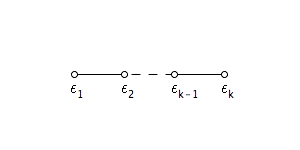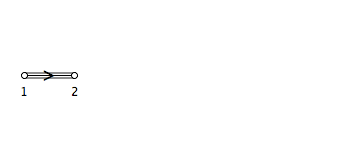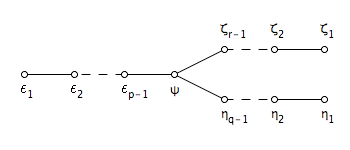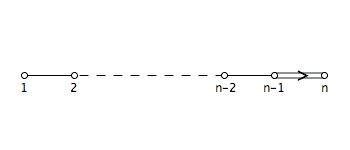Proving the Classification Theorem IV
We continue proving the classification theorem. The first three parts are here, here, and here.
- Any connected graph
takes one of the four following forms: a simple chain, the
graph, three simple chains joined at a central vertex, or a chain with exactly one double edge.
- The only possible Coxeter graphs with a double edge are those underlying the Dynkin diagrams
,
, and
.
This step largely consolidates what we’ve done to this point. Here are the four possible graphs:




The labels will help with later steps.
Step 5 told us that there’s only one connected graph that contains a triple edge. Similarly, if we had more than one double edge or triple vertex, then we must be able to find two of them connected by a simple chain. But that will violate step 7, and so we can only have one of these features either.


Here we’ll use the labels on the above graph. We define
As in step 6, we find that and all other pairs of vectors are orthogonal. And so we calculate
And similarly, . We also know that
, and so we find
Now we can use the Cauchy-Schwarz inequality to conclude that
where the inequality is strict, since and
are linearly independent. And so we find
We thus must have either , which gives us the
diagram, or
or
with the other arbitary, which give rise the the
and
Coxeter graphs.

Whoowee!
What program do you do your mathwriting in?
WordPress itself supports the writing. For these diagrams I’m using GeoGebra, while for big commutative diagrams I render them in TeXshop and cut/paste the images here.
writing. For these diagrams I’m using GeoGebra, while for big commutative diagrams I render them in TeXshop and cut/paste the images here.
Great work! I really enjoy these posts. You should consider joining up with Khan and making some videos of higher level maths.
You duplicated one line of the equations underneath “As in step 6…and so we calculate”.
Will you be going over how these tie in with polytopes?
Thanks, fixed it.
As it stands, I’m not planning on using the classification immediately. But it provides a nice break in the analysis work for a while.
[…] Proving the Classification Theorem V Today we conclude the proof of the classification theorem. The first four parts of the proof are here, here, here, and here. […]
Pingback by Proving the Classification Theorem V « The Unapologetic Mathematician | February 26, 2010 |